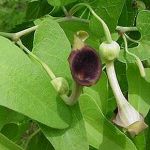| Common Name: |
Serpentary |
| Other Names: |
Virginia snakeroot |
| Botanical Name: |
Aristolochia serpentaria |
| Genus: |
Aristolochia |
| Family: |
Aristolochiaceae |
| Location: |
E and S USA |
| Cultivation: |
Well-drained soil in sun or partial shade, thin out previous year's growths or cut back to two or three nodes in late winter. Aphids, whitefly, and spider mite may damage foliage of plants under cover. |
| Propagation: |
By seed sown in spring at 13-16°C (55-61°F); by semi-ripe cuttings in summer; by division in early spring or autumn; by layering in autumn. |
| Harvest: |
Roots are harvested in autumnm and fruits collected when ripe, and dried for liquid extracts, decoctions, powders, and tinctures. Oil is distilled from dried roots (A. serpentaria). |
| Height: |
10-45cm (4-18in) |
| Width: |
10-45cm (4-18in) |
| Hardiness: |
Z6-9 |
| Parts Used: |
Roots, oil |
| Properties: |
A bitter, aromatic, tonic herb that induces perspiration, is anti-inflammatory, and acts as a diuretic. |
| Medicinal Uses: |
Internally for rheumatism, gout, arthritis due to fevers, pneumonia, typhoid, and malaria. Externally for pleurisy, herpes, and slow-healing wounds. Included in commercial tonics for the circulation, skin, and kidneys. For use by qualified practitioners only. |
| Economic Uses: |
Essential oil, similar to ginger and valerian odor, is used to flavor alcoholic drinks. |
| Warning: |
Toxic if eaten
This herb is subject to legal restrictions in some countries. |
| Bibliography: |
Encyclopedia of Herbs by Deni BrownCopyright © 1995, 2001 Dorling Kindersley Limited. pp. 129 |

